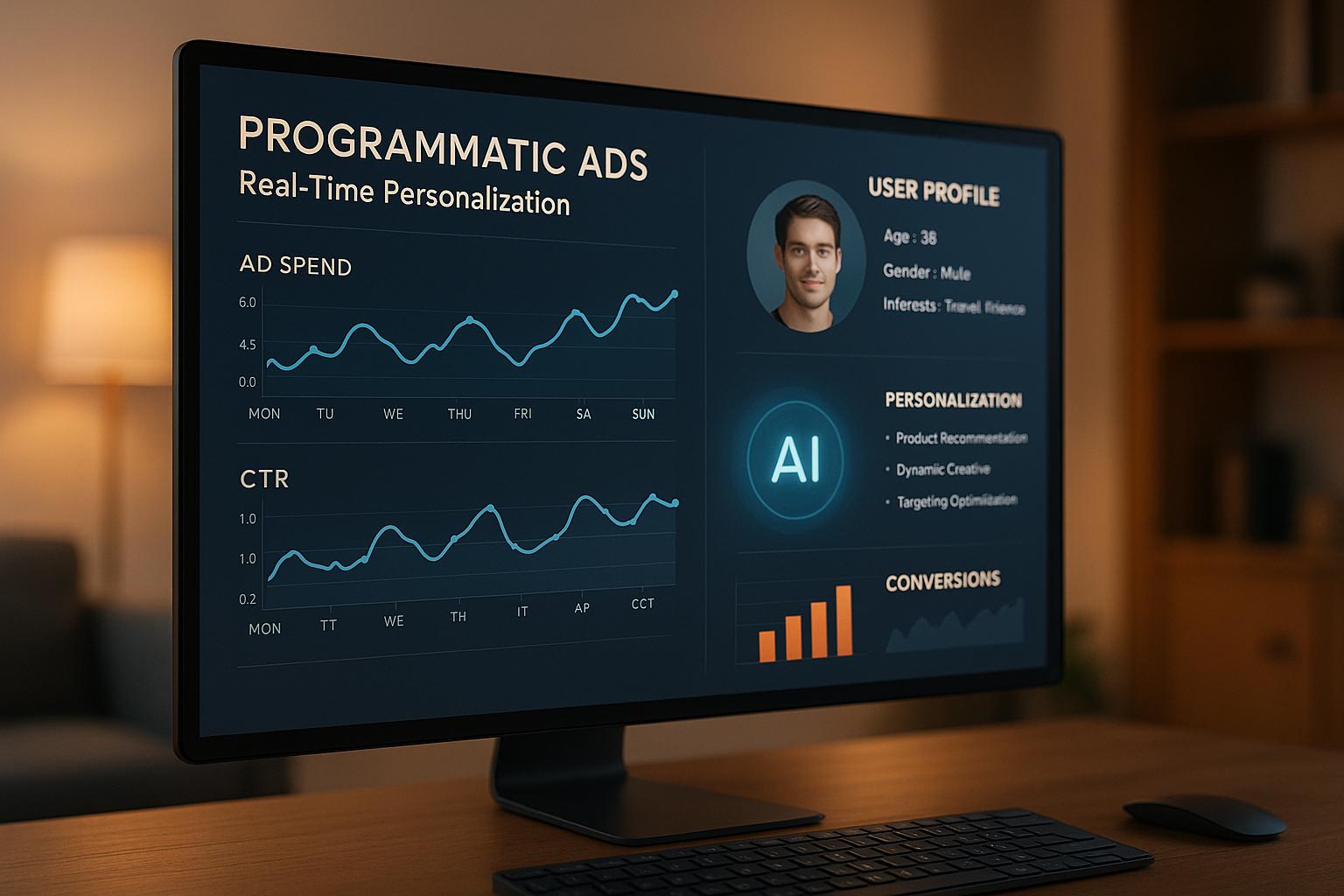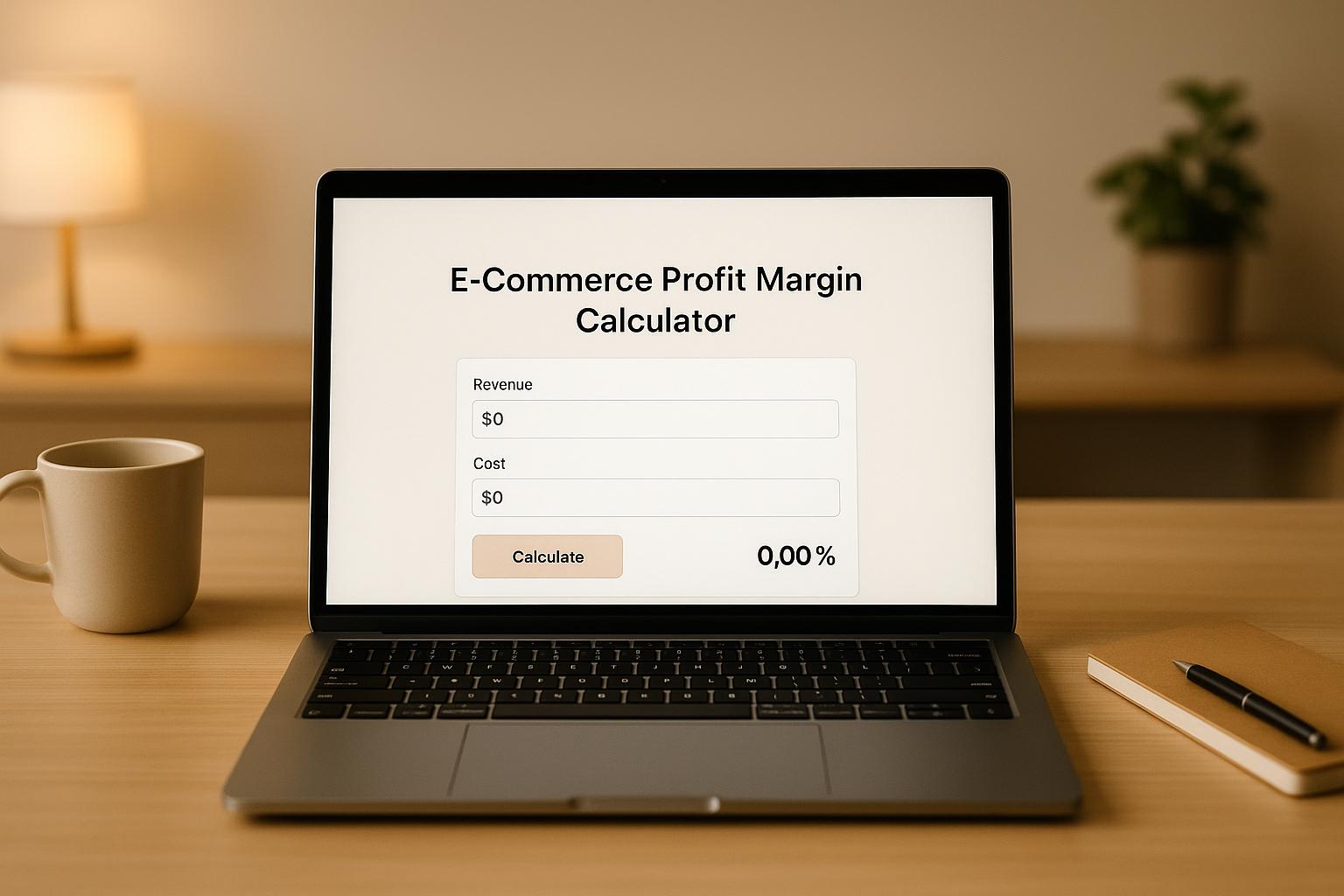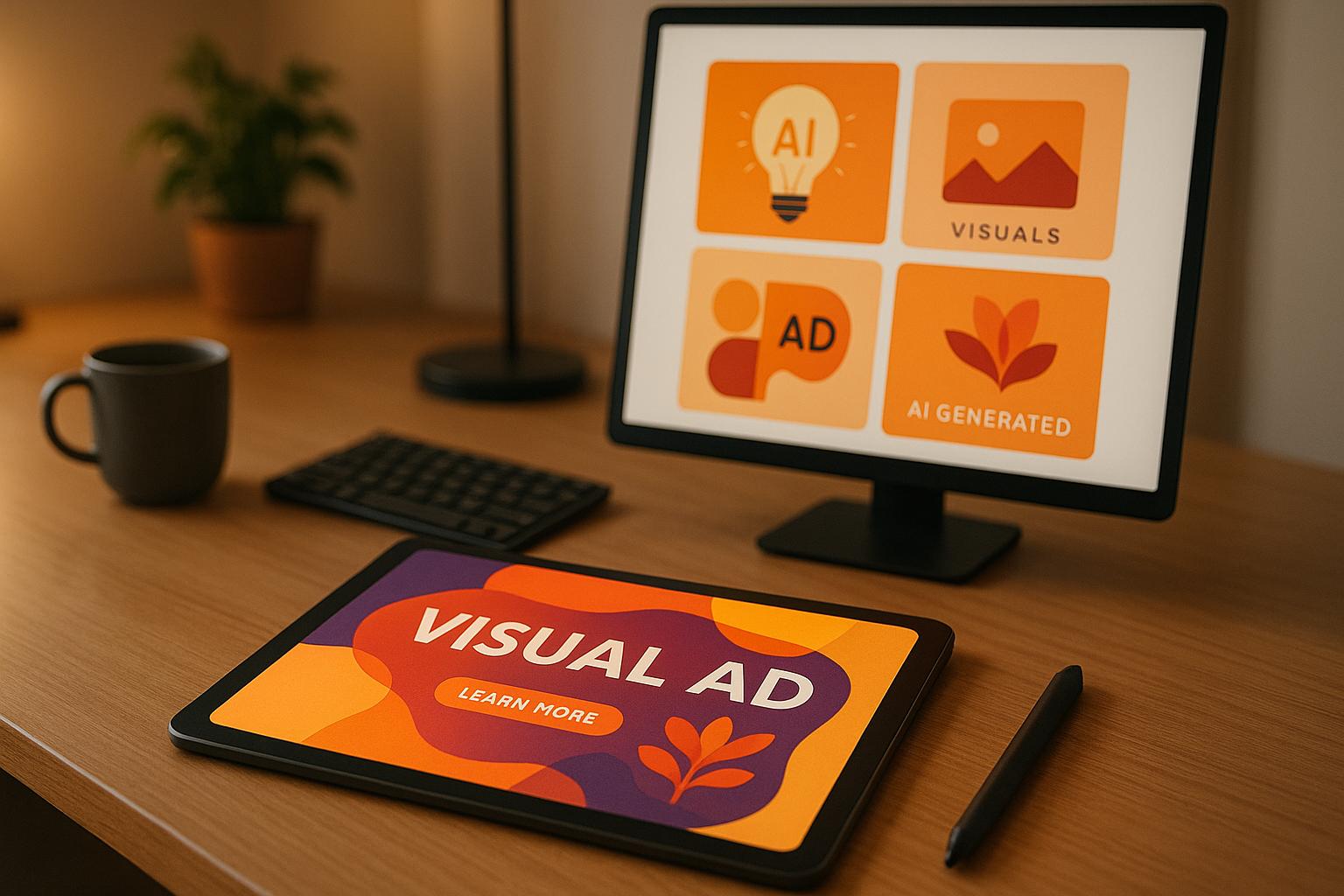Best Practices for AI-Driven A/B Testing
AI-driven A/B testing combines machine learning with traditional split testing, offering faster, smarter, and more efficient ways to optimize your campaigns. Here’s what you need to know:
- Speed: AI reduces testing time from weeks to hours by automating test creation and dynamically reallocating traffic to top-performing variations.
- Precision: It identifies micro-segments within your audience and tests multiple ad elements simultaneously for better insights.
- Automation: Platforms like Feedcast.ai streamline data preparation, generate personalized ad variations, and track performance across channels like Google and Meta.
- Clear Goals: Focus each test on one measurable objective, like increasing click-through rates or reducing cart abandonment.
- Data Quality: Clean, consistent data is critical. Errors or inconsistencies can skew results by up to 30%.
- Continuous Improvement: AI evolves with your audience behavior, updating segments and optimizing campaigns in real time.
AI-driven A/B testing not only saves time but also ensures your campaigns are data-driven and customer-focused. Platforms like Feedcast.ai make this process easier, offering tools for data preparation, automation, and unified tracking across multiple ad channels.
The ultimate guide to A/B testing | Ronny Kohavi (Airbnb, Microsoft, Amazon)
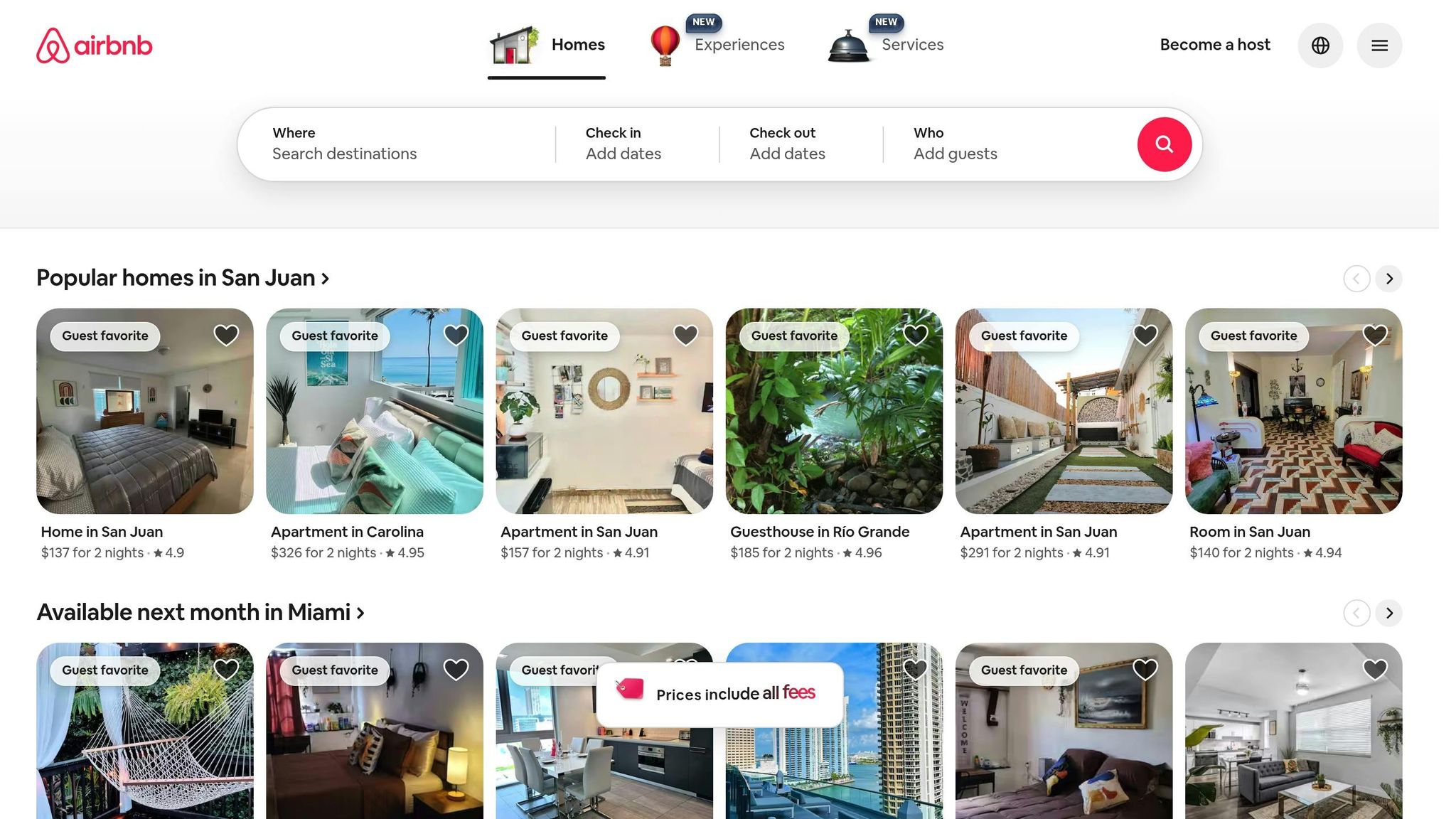
Setting Clear Goals for A/B Testing
A/B testing with AI can be powerful, but without clear and specific goals, it’s easy to end up chasing the wrong results. While AI excels at processing massive amounts of data and spotting patterns, it needs clear direction to avoid focusing on metrics that don’t align with your business priorities. Think of your goals as the guiding compass for your experiments - they ensure your efforts stay on track and deliver meaningful outcomes.
To make the most of A/B testing, every experiment should have a single, measurable objective that directly connects to what matters most for your business. This approach helps avoid distractions from vanity metrics that may look impressive but don’t contribute to revenue growth or customer satisfaction.
Creating Specific Goals for Each Test
Each test should focus on one measurable objective. Trying to measure multiple outcomes at once can muddy the waters, making it difficult to pinpoint what drove any changes in performance.
Your goals should be both specific and measurable. For example, instead of aiming to “improve the checkout process,” set a target like “increase checkout completion rate by 10% within the next month” [2]. This level of clarity helps AI algorithms zero in on what they need to optimize.
The most impactful tests often focus on high-traffic, high-value pages. Small improvements on these pages can lead to significant returns on investment [1][3].
Here are a few examples of measurable objectives to consider for your tests:
- Boost ad click-through rates by tweaking headlines or calls-to-action.
- Improve conversion rates on product pages with better descriptions or images.
- Reduce cart abandonment by simplifying the checkout process.
- Increase average order value with smarter product recommendations or pricing strategies.
Each goal should address a real challenge or opportunity, identified through customer feedback, analytics, or sales funnel data. This ensures your tests tackle genuine issues that matter to your business.
Once your goals are clearly defined, the next step is to measure success effectively.
Choosing Key Performance Indicators (KPIs)
To keep your tests focused, select one primary KPI for each experiment. This avoids confusion and ensures you can make clear, data-driven decisions [2]. The KPI you choose should directly reflect the outcome you’re aiming for. For instance:
- If your goal is to improve profitability, focus on metrics like revenue per visitor or cost per acquisition.
- If your priority is boosting engagement, track metrics like click-through rate or time spent on site [4].
Here’s how goals, test elements, and KPIs might align:
| Test Element | Example Goal | Example KPI |
|---|---|---|
| Checkout Process | Reduce cart abandonment | Conversion rate |
| Product Page | Increase add-to-cart actions | Add-to-cart rate |
| CTA Button | Boost click-throughs | Click-through rate (CTR) |
| Pricing Display | Raise average order value | Average order value (AOV) |
Statistical significance is key when working with KPIs. For most e-commerce A/B tests, you’ll need at least 5,000 to 10,000 visitors per variant to ensure reliable results [1]. This highlights the importance of targeting pages or elements with sufficient traffic.
While quantitative data provides critical insights, it doesn’t tell the whole story. Supplement test results with qualitative feedback from customer surveys or user interviews to understand why certain changes work - or don’t [1].
Tools like Feedcast.ai make goal-setting easier by offering unified reporting across all your advertising channels. Instead of juggling multiple dashboards, you can track progress toward your testing goals in one place. Plus, its AI-powered analytics can recommend relevant KPIs based on your campaign type and business objectives, saving you time and effort.
Preparing Quality Data for AI Testing
Once your goals are set, the next step is ensuring your data is in top shape. Why? Because the quality of your data directly impacts the accuracy of AI-driven test results. If your data is messy, incomplete, or inconsistent, even the smartest AI tools will struggle to deliver reliable insights. In fact, poor data quality can skew conversion rate measurements by as much as 30%, leading to flawed conclusions and wasted ad spend [1].
The good news? Preparing clean, consistent data doesn’t have to be daunting when you focus on the right areas and use the right tools.
Why Clean and Consistent Data Matters
Clean data is the backbone of reliable AI predictions. When your product information is inconsistent or incomplete, AI models can misinterpret user actions or misclassify products, which leads to test results that don’t reflect reality [1] [6].
Here are some common data issues that can derail your A/B testing efforts:
- Incomplete product information: Missing details can confuse AI algorithms.
- Inconsistent naming conventions: For example, "Men's Running Shoes Size 10" on one platform versus "Running Shoes – Male – 10" on another. AI might treat these as two different products.
- Duplicate records: Redundant entries clutter your data and skew results.
- Outdated inventory data: Incorrect availability or pricing can mislead your tests.
- Formatting errors: Inconsistent units, date formats, or pricing structures can trip up AI.
To avoid these pitfalls, regular data audits are crucial. These audits help you catch and fix errors, inconsistencies, and outdated information before they affect your test results. Depending on how often your product catalog changes, aim to audit your data monthly or quarterly.
During audits, focus on standardizing product attributes like titles, descriptions, and categories. For U.S. markets, ensure prices are formatted as $XX.XX, dates follow MM/DD/YYYY, and measurements use consistent units. Remove duplicate entries and fill in missing values to make your data AI-ready.
Clean data isn’t just a technical necessity - it can also have a real impact on your bottom line. High-quality data has been shown to boost conversion rates by 21.8% [2]. That’s why automating data preparation with smart tools can save you time and improve results.
Using Feedcast.ai for Product Data Improvement
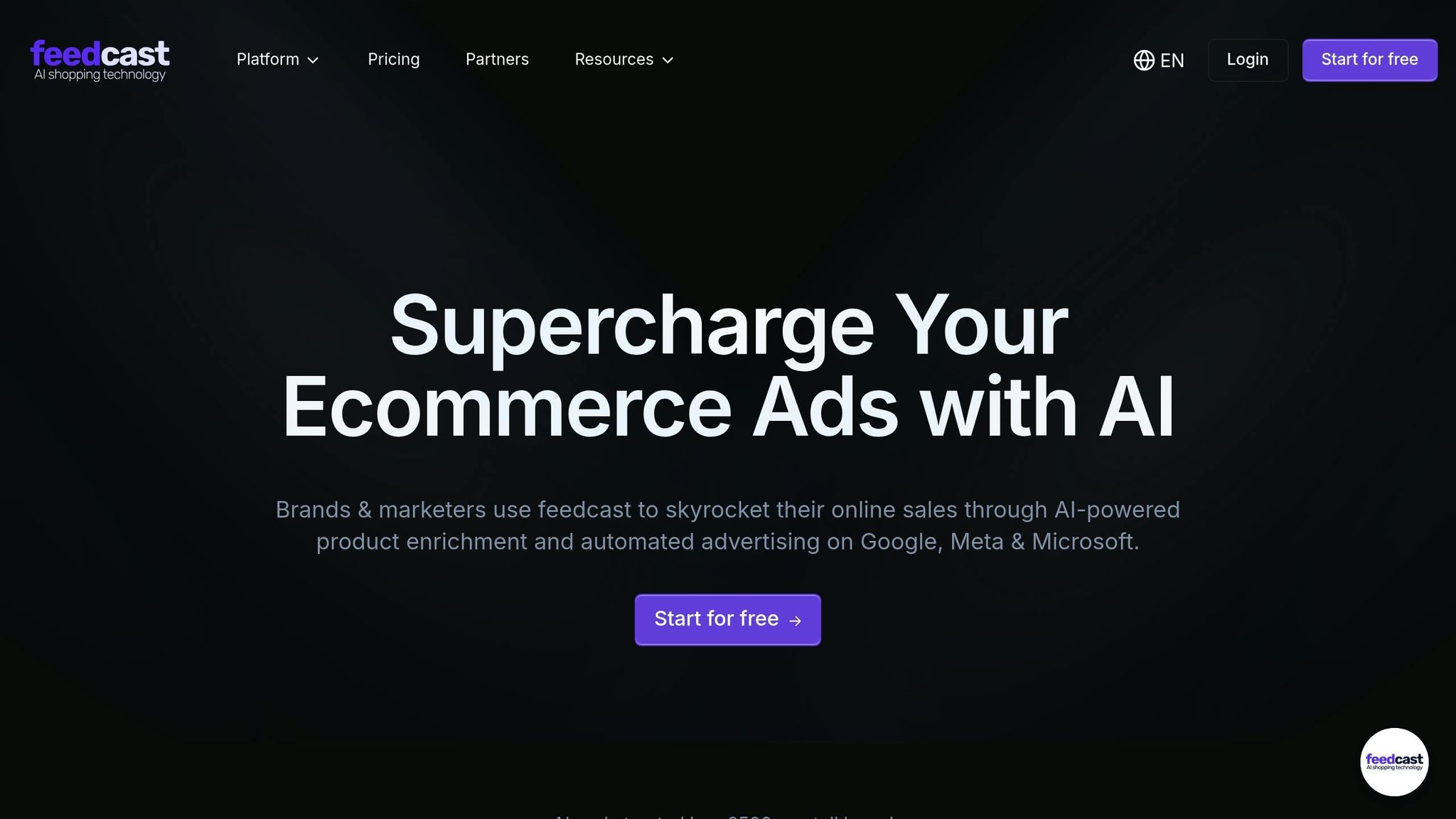
Enter Feedcast.ai, a platform designed to take the hassle out of data preparation. Its AI-powered tools handle the heavy lifting, refining product titles, descriptions, and attributes to optimize your data for both ad performance and A/B testing.
Feedcast.ai can import your product data from e-commerce platforms like Shopify, WooCommerce, and PrestaShop, or even from files like Google Sheets, CSV, or XML. Once the data is uploaded, the platform’s AI scans it for issues and identifies areas for improvement.
Here’s what Feedcast.ai does:
- Error Detection and Fixes: The platform automatically spots issues like missing descriptions, inconsistent categorization, or formatting errors. It then suggests or applies fixes, saving you hours of manual work.
- Data Enrichment: Beyond cleaning, Feedcast.ai enhances your product information. It refines titles with relevant keywords, improves descriptions for better ad performance, and ensures consistent attributes across all channels.
With enriched, polished data, your AI tools can deliver sharper insights during A/B testing. And the best part? You spend less time cleaning data and more time analyzing results.
Using AI for Test Design and Optimization
With quality data in hand and clear goals in place, AI is reshaping how we approach test design and optimization. Once your data is ready to go, AI steps in to streamline the process of creating and running A/B tests. By automating variation creation, adjusting traffic dynamically, and delivering insights faster, AI takes testing to a whole new level. Let’s break down how this works step by step.
Automating Test Variations with AI
Gone are the days of manually brainstorming test variations. Traditionally, marketers would spend hours coming up with headlines, crafting ad copy, and designing creatives. Limited time and resources often meant only a few variations could be tested. AI flips this script by generating a diverse range of test elements in a fraction of the time.
AI tools can quickly create multiple variations across different elements. For instance, when working on ad copy, AI can analyze your product data and suggest headlines that emphasize various selling points - like free shipping, high quality, or urgency with limited-time offers.
Multivariate testing takes this further by allowing AI to test multiple elements at once, uncovering combinations that traditional single-variable tests might overlook. AI also excels at personalization. Instead of sticking to a one-size-fits-all approach, it can tailor test elements for specific audience segments. For example, a fitness equipment retailer might use motivational messaging for busy professionals while offering performance-driven copy for serious athletes.
Platforms like Feedcast.ai take this automation to the next level. They use enriched product data to craft personalized ad copy tailored to each advertising channel. Whether it’s Google Shopping or Facebook ads, the AI ensures the messaging aligns with the platform’s unique audience, maximizing impact.
Dynamic Traffic Allocation and Real-Time Data
Traditional A/B testing often splits traffic evenly between variations and waits for enough data to roll in. AI-driven testing, on the other hand, uses smarter methods - like multi-armed bandit algorithms - to track performance in real time and shift traffic to better-performing variations.
For example, if one variation starts outperforming the others, the AI algorithm will automatically allocate more traffic to it. This approach not only speeds up learning but also boosts revenue during the testing period. By continuously monitoring key metrics and adjusting throughout the day, AI ensures underperforming variations are phased out quickly. Unlike traditional tests, which can take weeks to yield results, AI-driven testing delivers actionable insights much faster.
Traditional vs. AI-Driven A/B Testing
Here’s a side-by-side look at how AI-driven testing stacks up against traditional methods. The differences highlight why AI is becoming the go-to approach for forward-thinking businesses.
| Factor | Traditional A/B Testing | AI-Driven A/B Testing |
|---|---|---|
| Creation Time | Takes days to manually create variations | Generates multiple variations almost instantly |
| Number of Variations | Limited due to resource constraints | Tests a wide range of variations simultaneously |
| Traffic Allocation | Fixed, evenly split traffic | Dynamically adjusts traffic in real time |
| Time to Results | Requires weeks to gather insights | Provides insights much faster |
| Tailored Content Generation | Offers one-size-fits-all variations | Creates variations tailored to audience segments |
| Ongoing Optimization | Adjustments happen post-test | Continuously optimizes during testing |
| Statistical Analysis | Relies on basic significance testing | Uses advanced algorithms for deeper insights |
| Scalability | Limited by manual processes | Scales easily across multiple campaigns |
The shift to AI-driven testing isn’t just about saving time - it unlocks new opportunities for deeper insights and ongoing optimization. For e-commerce businesses using platforms like Feedcast.ai, these tools enable continuous testing and improvement across multiple advertising channels. By automating variation creation, dynamically managing traffic, and leveraging real-time data, you can test more ideas, get faster results, and ultimately boost conversions and revenue. This approach naturally sets the stage for refining audience targeting with AI.
sbb-itb-0bd1697
Improving Audience Targeting with AI
Once you’ve automated your test variations and optimized traffic, the next step is to use AI to target your audience more effectively. Traditional methods often depend on broad demographics or basic behavioral data, which can miss key insights. AI takes audience targeting to the next level by analyzing complex patterns in customer behavior, purchase history, and engagement data. This allows you to create highly specific audience segments, making your A/B tests more impactful and driving better results.
AI-Powered Audience Segmentation
AI digs deeper into customer intent by examining browsing habits, purchase history, and even cart abandonment trends. Machine learning algorithms can process a wide range of data - like which pages users engage with, seasonal buying patterns, and past purchases - to build detailed customer profiles. It can also identify lookalike audiences by comparing your best customers’ behaviors with broader audience trends. For example, if your top customers tend to research products thoroughly before buying and value detailed product specs, AI can target similar prospects with ads that highlight in-depth product details.
AI doesn’t stop there. It can spot seasonal buying patterns and adjust your messaging to hit at just the right time. For instance, if your data shows a spike in demand for certain products during the holidays, AI can ensure your ads are perfectly timed and tailored to those trends.
If you’re using platforms like Feedcast.ai, this segmentation happens seamlessly across multiple advertising channels. AI integrates customer behavior data from platforms like Google, Facebook, and Microsoft Ads, creating unified audience profiles. This ensures that whether your customers see your ads on Instagram, Google Shopping, or elsewhere, your segmentation strategy stays on point. These finely tuned segments then serve as the foundation for personalized messaging in your A/B tests.
Testing Personalized Recommendations and Messages
With detailed audience segmentation in place, AI can personalize recommendations and messaging for each group. By analyzing customer data, AI crafts product suggestions and messages that feel tailor-made for specific audience segments, elevating the quality of your A/B test variations.
For example, instead of showing everyone the same generic product list, AI can deliver dynamic recommendations. A customer who previously bought athletic gear might see suggestions for sports accessories, while another customer could receive offers based on their unique buying patterns.
AI also adapts messaging based on where the customer is in their buying journey. First-time visitors might see educational content highlighting product benefits, while returning customers who abandoned their cart could be shown urgency-driven messages about limited stock or time-sensitive discounts.
Consistency across platforms is another strength of AI. A customer who clicks on a personalized Facebook ad will encounter related messaging when they visit your Google Shopping page, creating a seamless experience that reinforces your brand and boosts conversion rates.
Updating Segments with AI Data
AI doesn’t just create audience segments - it continuously updates them based on real-time data. Unlike static lists that can quickly become outdated, AI-powered segments evolve as customer behavior changes. For instance, if a customer shifts from casually browsing to actively adding items to their cart, AI updates their segment so they receive the most relevant messages.
AI also refines segments by analyzing performance data and spotting emerging trends. If customers in a certain region respond better to video ads than static images, the AI can tweak targeting parameters to reflect this. This feedback loop ensures that every campaign benefits from the lessons learned in previous tests.
Regularly monitoring segment health - by tracking metrics like engagement rates, conversion performance, and segment size - keeps your targeting strategy sharp. If a high-performing segment starts to decline, AI can adjust its criteria or suggest new approaches to testing.
Platforms like Feedcast.ai simplify this process by centralizing audience data and insights in one dashboard. This unified view helps you identify what’s working and apply those strategies consistently across platforms like Google, Facebook, and Microsoft Ads. The result? A system that continuously improves your advertising outcomes.
Analyzing and Improving Test Results
To fuel business growth, it's crucial to analyze test results effectively. By combining AI's powerful data-crunching capabilities with human expertise, you can create a feedback loop that keeps improving your campaigns over time.
Tracking Metrics Across Multiple Channels
Start by tracking key metrics like conversion rate, CTR (click-through rate), bounce rate, AOV (average order value), and revenue per visitor. These metrics should align with your campaign goals. A unified tracking system is essential to capture the entire customer journey. Without it, you risk making decisions based on incomplete data, missing critical cross-channel interactions.
Platforms like Feedcast.ai simplify this process by offering a unified dashboard. You get real-time data, custom reports, and detailed segmentation across platforms like Google, Meta, and Microsoft Ads - all in one place. This eliminates the hassle of jumping between dashboards and ensures you have a full view of your campaign performance.
For accurate insights, aim for a sample size of 5,000–10,000 visitors per variant[1]. Many AI platforms can help calculate the optimal sample size and testing duration based on your historical data, ensuring your results are statistically reliable before making campaign changes.
Once you’ve gathered the data, blend it with human analysis for a deeper understanding.
Combining AI Data with Human Analysis
AI excels at processing massive datasets and spotting patterns you might miss. But it’s human analysis that adds the context needed to make those insights actionable. Together, they create a balanced approach that aligns data with your business goals[5].
For example, AI might highlight a variant with a higher CTR. At first glance, this seems like a win, but human judgment is needed to dig deeper. Does this increased engagement translate to more sales? If the higher CTR comes from clickbait headlines that don’t convert, the insight needs re-evaluation. Similarly, while AI can identify trends, humans are better at recognizing external factors - like seasonal shifts, competitor moves, or market changes - that might influence the data.
Relying solely on AI can lead to misinterpreted results. A combination of AI insights and human expertise ensures your conclusions are both statistically valid and strategically relevant.
Don’t forget the value of qualitative data. Numbers alone can’t tell you why something worked - or didn’t work. For instance, if a new call-to-action button underperforms despite AI predicting success, tools like user surveys or live chat feedback might reveal that customers found the wording unclear or the design unappealing. These insights can guide your next round of testing, preventing missteps based purely on numbers.
Once you’ve contextualized your data, the next step is to adapt to changing customer behavior.
Updating Tests Based on Customer Behavior
Using unified tracking and AI-human insights, keep your tests updated to reflect shifts in customer behavior. A/B testing should be an ongoing process because customer preferences and market conditions are always changing. Businesses that succeed are those that embrace continuous testing[1].
AI platforms can make this easier by monitoring performance in real time and flagging when a previously successful variant starts to lose its edge. For example, if a product description that once performed well starts seeing lower engagement, AI can alert you to adjust your tests. This proactive approach helps you address performance dips before they hurt your bottom line.
Keep a detailed record of your test outcomes to identify patterns that can shape future campaigns[1][5]. For instance, if urgency-based messaging consistently performs better on weekends or video ads outperform static images for certain products, these insights become invaluable for your strategy moving forward. Use this information to tweak your ad creatives, refine audience targeting, and monitor performance to stay ahead.
Even when A/B tests don’t deliver the results you hoped for, they’re still valuable. A test that doesn’t hit statistical significance might reveal hidden customer preferences or highlight areas worth exploring further. By documenting what you tested, why you tested it, and what you learned - regardless of the outcome - you build a foundation for continuous improvement. Every test, whether it succeeds or "fails", is a step toward refining your strategy.
Key Points for AI-Driven A/B Testing Success
As discussed earlier, AI has transformed the way we approach testing. Now, let’s dive into strategies that can help you make the most of AI-driven A/B testing. While this method offers a significant upgrade from traditional testing techniques, success hinges on following proven practices and using the right tools to achieve optimal results.
How AI Enhances Modern A/B Testing
AI takes the heavy lifting out of A/B testing by automating key processes like hypothesis generation, test execution, and analysis. This allows e-commerce businesses to run experiments more quickly and efficiently[5]. Unlike manual methods, AI can sift through massive datasets, uncovering patterns that might go unnoticed by human analysts. It also optimizes test variations in real time, ensuring better outcomes.
One of AI’s standout features is its ability to dynamically allocate traffic and personalize audience targeting. This means tests can adjust on the fly, funneling more visitors to the top-performing variations. This not only speeds up the process but also reduces the time needed to reach statistically significant results - something traditional methods struggle to accomplish at scale[5].
AI also shines when analyzing complex customer behavior across multiple touchpoints. While human analysts may miss subtle trends, AI can quickly identify correlations between factors like demographics, browsing habits, and conversion rates. That said, AI isn’t a magic wand; it still requires clear goals and quality data to deliver actionable insights[5].
For e-commerce businesses juggling multiple campaigns across various channels, AI’s combination of speed and accuracy is invaluable. Instead of manually tracking every test, AI can automatically detect performance shifts and recommend adjustments. This allows your team to focus on strategy and creative tasks rather than getting bogged down in data analysis.
Steps to Get Started
To harness the full potential of AI in A/B testing, follow these critical steps:
Define clear objectives and KPIs: Setting specific goals is essential for guiding AI optimization. Vague targets can lead to wasted resources if AI focuses on the wrong metrics[5][2]. For example, if your aim is to boost completed checkouts, prioritize metrics like conversion rates over time spent on the site. KPIs such as click-through rates, bounce rate improvements, or revenue per visitor ensure that AI decisions align with your business goals.
Prioritize data quality: High-quality data is the backbone of successful AI-driven testing. Poor data can lead to misleading results. Tools like Feedcast.ai can enhance your data management by enriching product descriptions, fixing feed errors, and maintaining consistency across channels. This not only improves ad performance but also ensures reliable test outcomes.
Focus on high-impact pages: Start by testing pages that directly influence your bottom line, such as your homepage, product pages, or checkout process[1][3]. For instance, Clear Within saw an 80% increase in add-to-cart rates by optimizing their product page layout to highlight trust and transparency while improving call-to-action placement[7].
Leverage AI tools for automation and tracking: Platforms like Feedcast.ai simplify ad management by centralizing operations across channels, automating ad creation, and providing real-time analytics in one dashboard. This eliminates the need to switch between platforms and ensures full visibility into campaigns on Google, Meta, and Microsoft Ads.
Test one variable at a time: To gain reliable insights, focus on single-variable tests. A study of 2,732 A/B tests found that isolating variables - like headlines, images, or button colors - yields more accurate results than testing multiple elements simultaneously[7]. This approach helps pinpoint exactly what drives performance changes.
Commit to ongoing testing and refinement: Consumer preferences and market trends are always shifting. What works today might not work tomorrow[1]. Use insights from both successful and unsuccessful tests to guide future experiments. Even tests that don’t show statistically significant results can reveal valuable customer preferences worth exploring further.
FAQs
How does AI-driven A/B testing make marketing campaigns faster and more accurate than traditional methods?
AI-powered A/B testing takes marketing campaigns to the next level by automating the analysis of customer interactions and adjusting strategies in real time. Unlike older methods that rely on manual setup and lengthy analysis, AI can test numerous variables simultaneously, pinpoint the most effective options, and fine-tune campaigns as they run.
With machine learning at its core, this approach delivers quicker insights, sharper audience targeting, and tailored experiences on a large scale. The result? Marketers save time and effort while ensuring their campaigns are guided by data, leading to stronger outcomes and helping them hit their goals with greater precision.
How can I prepare my data for accurate results in AI-driven A/B testing?
To achieve dependable outcomes from AI-powered A/B testing, you need to make sure your data is clean, accurate, and consistent. This means getting rid of duplicates, addressing any missing values, and standardizing formats such as dates, currencies, or measurement units. When your data is organized and well-prepared, it minimizes biases and allows AI models to generate insights you can actually use. Investing time in validating and prepping your data upfront ensures more reliable and meaningful testing results.
How does AI-driven A/B testing improve audience targeting and marketing personalization?
AI-powered A/B testing takes the guesswork out of marketing by analyzing massive datasets with speed and precision. It uncovers patterns in audience behavior, demographics, and other critical data points, allowing you to fine-tune campaigns to better connect with specific groups.
What sets AI apart is its ability to automate the entire testing process. It can generate hypotheses, test different variations, and adjust strategies on the fly. This means your campaigns stay sharp and relevant, driving stronger engagement and more impactful results.
Geoffrey G.

